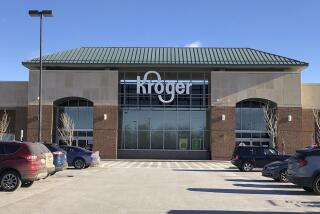Hoping Fixers Will Be Uppers
- Share via
Sears, Roebuck & Co. has generated considerable consumer success by marketing its “softer side.” Now the retailer that revived moribund stores with a dramatic infusion of well-known name brands is methodically attacking the “service side.”
The high-powered retailer is hoping to grab more of the $160 billion that Americans spend each year to fix broken washing machines, patch leaky roofs and remodel aging bathrooms.
And Sears, which wants to triple the size of its $3-billion home service business during the next three years, isn’t the only big brand invading an industry made up mostly of mom-and-pop operators.
Tandy Corp.’s Radio Shack chain is courting consumers who need repairs made to their stereos and CD players--no matter the make or brand and regardless of where the items were purchased.
Real estate agents say Century 21, now a part of Parsippany, N.J.-based HFS Inc.’s growing stable of companies, is contemplating an array of services for home buyers. And as the utility industry is deregulated, Edison International and Southern California Gas Co. are entering everything from computer repair to home security systems.
The big companies are betting they can steal business from small operators by leveraging their well-known brand names. Industry observers suspect it won’t be long before regional telephone companies, cable TV providers and other companies with a national scope join the fray.
*
Speaking earlier this year to the National Retail Federation, futurist Alvin Toffler predicted that many familiar companies will start to offer “services such as painting, plumbing and remodeling. . . . As they get more information about their customers’ needs, this will happen.”
In most cases, the big companies hope to replenish revenue streams by tapping into a business that isn’t likely to dry up during a recession. They also figure there’s plenty of room in the fragmented industry for companies with nationally known names. Some of them simply want to repair your broken appliances, while others are pitching long-term service contracts.
Your local repairman might show up in a new corporate uniform one of these days, because some of the new arrivals to the market are licensing their names and logos to existing companies rather than hiring armies of repairmen.
But these corporate fleets now fanning out across the country face significant obstacles. Failing to deliver service promptly and at a fair price could result in a public relations black eye, as Sears learned earlier this decade. The retailer ended up distributing $46.6 million in coupons to customers nationwide following an auto repair fraud investigation in California.
Century 21 is now embroiled in litigation in connection with the 1995 acquisition of a home repair and renovation company purchased as part of the real estate giant’s plan to offer home buyers “one-stop shopping.”
And Tandy failed a few years ago when it experimented with a chain that was designed to sell and service appliances and electronic goods. “It turned out not to be a very profitable entity for Tandy. And it doesn’t exist anymore,” said Marcus Fearnehough, owner of a small shop in Santa Cruz and president of the Cypress-based Professional Servicers Organization of California.
The majority of home repairs are completed on time and at the agreed-upon cost, said Marv Lurie, communications director for the Lake Napierville, Ill.-based National Assn. of Service Dealers, which represents more than 2,000 repair companies nationwide.
*
Since consumers are rarely prepared for the dishwasher overflowing or the television set whimpering and dying, when it does they start a frantic search for neighbors and co-workers with names of repair outfits that offer reliable service at a reasonable rate.
Alfred Pinkerton, who repaired heating systems before beginning a career in mortgage banking, knows a bit about the service business. And he didn’t relish the thought of calling a repairman recently to fix an aging refrigerator that was icing up.
“Too many of them try to B.S. you, and that’s frustrating because you know they’re not telling the truth,” said the 67-year-old Costa Mesa resident.
The retiree called Sears to fix the balky General Electric appliance. And he was happy with the outcome: The repairman had the required parts and the bill was $130. It would have cost him more than $500 to replace it.
As they approach customers like Pinkerton, Sears, Edison and Century 21 are marketing themselves as logical alternatives for harried consumers. In their advertising, they portray themselves as the reliable retail chain, the dependable utility company or the service-oriented real estate firm.
In essence, they’re betting that consumers will pick repair service the same way they buy toothpaste.
“Brands simplify consumer decision-making,” said Elaine Bolle, a former Western Union executive who now serves as marketing vice president of Sears HomeCentral. “They provide a consumer with a certain set of promises. Consumers like that, because every time they need something, they don’t have to rethink their options.”
These image-conscious companies aren’t shy about flashing their familiar logos in consumers’ faces.
Sears is using a pair of slogans--”The service side of Sears” and “Call someone you know”--for its HomeCentral business. It is opening service counters in its stores, plastering the HomeCentral name on 13,000 service vehicles and outfitting its 40,000-member army of technicians in new uniforms.
Edison International incorporates its familiar sunburst logo on all of its mailings--and recently agreed to pay $1.4 million a year to put its name on Anaheim Stadium. And, if you look closely at Energy Pacific service trucks, you’ll see Southern California Gas’ flame logo--and the words “An affiliate of the Gas Co.”
“We fully intend to take advantage of the fact that people are comfortable with the products and services offered by Edison,” said Mike Merlo, president of Edison Select, which is rolling out a wide array of services, from appliance repair to residential security.
*
Operators of small appliance and electronics repair shops don’t relish the thought of being invaded by deep-pocketed companies with considerable marketing savvy. But they’re not necessarily running up white flags.
“They’re going to try and take customers from me,” said Fearnehough. “But the single most important source of business is repeat customers and referrals. And I intend to keep those people.”
The search for new revenue by the big firms is driven by powerful market forces.
Retailers are scrambling to buffer their core businesses at a time when profit margins are being squeezed by discount chains. Power companies want new sources of revenue for when the electric and gas industries are deregulated. And real estate companies hope to pump up revenue streams in order to increase their profits.
Big companies are focusing on the home service sector, experts say, because there are few dominant players in what’s largely a cottage industry.
*
Profit margins in the repair business are being narrowed by increased competition--particularly in the electronic goods market, where prices keep falling. But many companies see a silver lining in the form of service contracts sold with new products.
“The profits associated with service contracts are double or triple the margins retailers make on the goods they’re selling,” Fearnehough said. “So, increasingly, that’s how companies like Sears are making their money.”
As they court consumers, the big players are trying to convince customers that their size is a plus. Most of them offer 800 numbers and around-the-clock service.
Edison encourages its service-contract customers to pay through their monthly electric bill--and will make arrangements to have payment plugged into the phone bill if the customer lives outside its service territory.
As competition heats up, it’s far from certain whether there will be room for all the new players. Margins will be fattest in upscale goods because consumers are likely to throw away cheaper CD players and VCRs rather than have them repaired. And even though consumers are loyal to certain brands, there’s no guarantee they’ll stick with a given company for service.
“Say Sears loses you as a customer,” said Clyde Nabors, executive director of the National Electronics Service Dealers Assn. in Fort Worth. “Well, they have to go out and spend more on advertising and promotion to get another customer.
“‘Everybody wants a piece of the pie,” Nabors said. “And that pie is starting to get sliced pretty thin.”
(BEGIN TEXT OF INFOBOX / INFOGRAPHIC)
Unhappy Customers
Here are the leading categories for calls about unsatisfactory repair work received over a one-year period by the Bureau of Electronic and Appliance Repair, a unit of the California Department of Consumer Affairs that oversees and licenses repair shops.
Rank: 1
Item repaired: Televisions
Complaints about repair work: 225
*
Rank: 2
Item repaired: Personal computer printers and monitors
Complaints about repair work: 197
*
Rank: 3
Item repaired: Refrigerators, freezers
Complaints about repair work: 150
*
Rank: 4
Item repaired: VCRs
Complaints about repair work: 118
*
Rank: 5
Item repaired: Washing machines
Complaints about repair work: 67
Note: Numbers are for calls for the period July 1, 1996, to June 30, 1997. Some calls involved multiple complaints.
More to Read
Inside the business of entertainment
The Wide Shot brings you news, analysis and insights on everything from streaming wars to production — and what it all means for the future.
You may occasionally receive promotional content from the Los Angeles Times.










